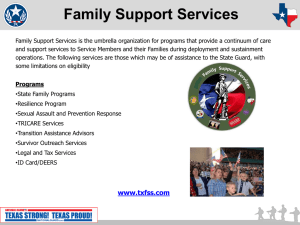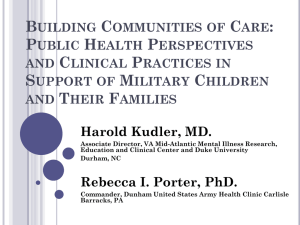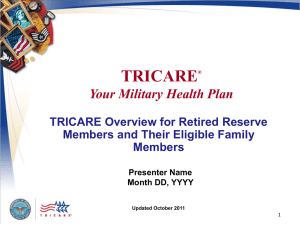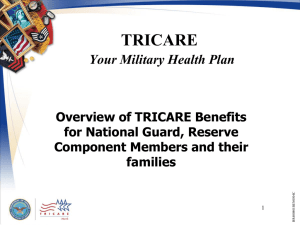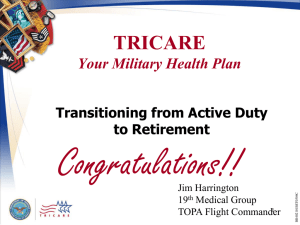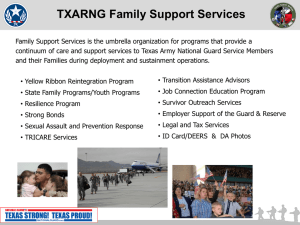Monitoring the Status of the Force
advertisement
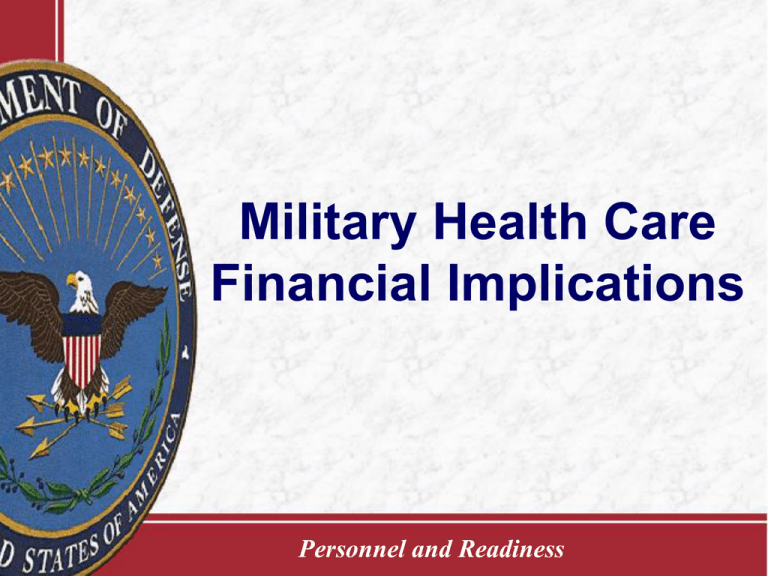
Military Health Care Financial Implications Personnel and Readiness Agenda Military Health System 101 Why are we growing? Efficiency Initiatives What are we doing? Beneficiary Cost Shares Other things we can be doing Sustainable over time? Military Health System 101 The Military Health System Has an Interconnected, Mutually-Supporting, Multi-Pronged Mission Be prepared to deploy to support COCOMs – combat casualty care, humanitarian assistance, disaster relief; and SSTRO – stability, security, transition and reconstruction operations Ensure a healthy, fit, protected force Manage/deliver care to build healthy, resilient families & communities Deploy to Patient Care, Sustain Skills to Support and Combatant and Training Commanders Manage and Deliver Beneficiary Care Deploy Medical Capability Promote & Protect Health of Force and Communities Support Homeland Defense Deploy Fit and Protected Force The MHS Ensures a Joint En-Route Patient Evacuation System…from Foxhole to Home Aerovac 3500nm/7hr 32min Landstuhl Army Regional Medical Center 1825nm/ 4hr 39min 1415nm/ 3hr 37min VA Forward Surgery Mosul Wilford Hall Air Force Medical Center National Naval Medical Center Walter Reed Army Medical Center USNS Comfort Bagram Balad Baghdad 1486nm/ 3hr 52min Medevac Emergency Medicine US Based Medical Centers and Research Expertise Hospitalization The MHS is a Vast Healthcare Enterprise, Serving the World’s Best Patients RESOURCES • $51 Billion FY2011 Unified DoD Medical Budget • 138K military and civilian personnel • Expansive Infra- and InfoStructure 9.5 M BENEFICIARIES • AD and families, RC and families, retirees and families, survivors, and others – worldwide • 5.0M Prime Enrollees FY 2011 FACILITIES • 56 Hospitals • 363 Ambulatory Clinics • 275 Dental Clinics • 288 Veterinary Clinics • 10 Medical Installations • USUHS / METC • 7 Research Laboratories EVERY WEEK • 21K Admissions (5K MTF) • 1.8M Visits (642K MTF) • 2.1K Births (1K MTF) • 2.2M Scripts (948K MTF) • 103K Dental Visits (MTF) • 3.5M claims processed ROBUST NETWORK • TRICARE network of 210K+ private-sector physicians, nearly all civilian hospitals, and 55K pharmacies • VA partnerships WORLD CLASS DEPLOYED SYSTEM • Foxhole to Home – doctrinally aligned Joint execution Our Ultimate Goal • Readiness • • • • Pre- and Post-deployment Family Health Behavioral Health Professional Competency/Currency • Quality Outcomes Healthy Service Members, Families, and Retirees • A Positive Patient Experience Patient- and Family-centered Care, Access, Satisfaction • Cost Responsibly Managed Readiness Military Health System Components Office of the Assistant Secretary of Defense (Health Affairs) TRICARE Management Activity Military Medical Departments / Services – Units / Personnel DHP Funded Line and Deployed Medical Units / Personnel Chairman of the Joint Chiefs of Staff medical personnel Combatant Commanders’ Surgeons staffs Education, Training, and Research Assets TRICARE Providers (individual providers, hospitals, pharmacies) Strategic Partnerships (e.g., interagency, international, and internal/external stakeholders) FY2011 Defense Health Program Budget Operation and Maintenance (In Billions) FY2011 Defense Health Program Budget (Operation and Maintenance) Health Care Support $16.1B 54% $6.0B 20% 26% $1.5 $5.3 $0.6 $0.4 $0.0 $7.8 $7.8B 26% In-House Care Private Sector Care In-House Care In-House Support* Pharmacy (CONUS/OCONUS) Health Care/Administrative Active Duty Dental Overseas Health Care Other Total *Excludes $4.2B associated with MilPers Private Sector Care Health Care Support Data Source: Defense Health Program FY2011 Budget Submission Private Sector Care Pharmacy (CONUS/OCONUS) Health Care/Administrative Active Duty Dental Overseas Health Care Other Total Health Care Support* Consolidated Health Information Management/Technology Management Activities Education and Training Base Operations Total *Excludes $3.6B associated with MilPers 54% $2.2 $12.3 $0.1 $0.3 $1.1 $16.0 20% $2.1 $1.5 $0.3 $0.6 $1.6 $6.1 Defense Health Program Component Overview FY 2011 Unified Medical Budget (millions) As of FY 2011 Budget Estimates Submission DHP Appropriation: Army $6,588 $118 $50 $6,757 Navy $3,195 $69 $38 $3,303 MILPERS* $2,479 MILCON $479 BRAC MERHCF O&M Receipts $566 MERHCF MILPERS Receipts $133 Total Budget Authority $10,413 $2,511 $150 $2,801 $165 $306 $119 $6,389 $418 $165 $5,938 O&M Procurement RDT&E Total DHP Air Force TMA OPNS $2,297 $1,657 $56 $276 $37 $348 $2,390 $2,280 USUHS $131 $0 $21 $153 TMA PSC Total $16,047 $29,915 $1 $520 $6 $500 $16,053 $30,935 $153 $7,791 $1,030 $410 $8,940 $416 $49,522 Other Sources: $235 $410 $10 $7,641 $2,936 $23,694 *MILPERS reflects updated rates as of 20 Jan 2010 Manpower Infrastructure Army Army Navy Air Force Total Inpatie nt Facilitie s 24 19 13 Navy Air Force TMA¹ Total Military End Strength 26,207 27,220 31,519 47 84,946 Civilian FTEs 31,685 13,257 6,953 1,383 53,278 57,892 40,477 38,472 1,430 138,224 45% 67% 82% 56 Me dical Clinics 157 126 80 363 De ntal Clinics 144 38 93 275 Percent Military Ve te rinary Clinics 288 0 0 288 ¹ TMA Military included in Service totals; USUHS Civilians (669) included in TMA total Total (FY 2010) Budget Impact DoD Forecast $70.00 If DoD Health Budget grows at recent trend rates, it will reach $64B, or 10.4% of DoD top-line in 2015 $60.00 $50.00 Annual Total Defense Health Expenditures ($B) If DoD Health Budget managed to 8% of DoD top-line, budget would be $46 in 2015 $40.00 $30.00 $20.00 $10.00 $0.00 FY06 FY07 FY08 FY09 FY10 Maintain Health Budget at 8% of Total DoD Budget FY11 FY12 FY13 FY14 FY15 Projections are for 10.4% by FY2015 Why Are We Growing? Evolution of Health Benefits 1940s-1950s 2002 Title 10 Legislated Benefit Space Required for Active Duty Space Available for Families and Retirees TRICARE Plus TRICARE For Life TRICARE Prime Remote for AD Family Members 1966 CHAMPUS Legislated Benefit Civilian Health Care Where MTFs Do Not Exist Families and Retirees <65 2003 TRICARE Online TRICARE implements HIPPA Patient Privacy Standard Elimination of AD Family Member Co-Pays 1993 TRICARE Managed Care Legislation Automatic enrollment for Active Duty Space Required for TRICARE Prime Enrollees Space Available for Non-enrollees 2004 Transitional Assistance Management Program (TAMP) Expansion Guard/Reserve TRICARE (Early Eligibility, Reserve Family Demo) Elimination of Non-Availability Statements (NAS) 1995-1998 TRICARE Triple Option Benefits Prime, Extra and Standard TRICARE Senior Prime Demonstration 2005 TRICARE Reserve Select Extended Health Care Option/Home Health Care (ECHO / EHHC) TRICARE Maternity Care Options 1999-2000 Further Expansion: Prime Remote for Active Duty TRICARE provider rates >=Medicare Beneficiary Counseling & Assistance Coordinators 2006 Extended TRICARE Benefits for Dependents Whose Sponsor Dies on Active Duty Limit Deductibles/co-Pays for Nursing Home Residents under the Pharmacy Program Enhancement of TRICARE Reserve Select Coverage 2001 Catastrophic Cap Reduced to $3,000 Enhanced TRICARE Retiree Dental Program TRICARE Senior Pharmacy Elimination of Prime Co-pays for AD Family Members Extension of Medical and Dental Benefits to Survivors School Physicals Entitlement for Medal of Honor Recipients TRICARE Prime Travel Entitlement Chiropractic Care Program 2007 Expansion of TRICARE Reserve Select coverage to All Reservists Three year Extension of Joint DoD/VA Incentive Program Planning/Management – Claims Processing Standardization Expanded Disease Management Programs Coverage of Forensic Exams for Sexual Assaults Dental Anesthesia for Pediatric Cases TRICARE Beneficiary Cost Share Has Gone Down For Family of Three Reason for decrease: Kaiser changes between High and Standard in 2007 $18,000 $16,000 $14,000 $12,000 $10,000 $8,000 $6,000 $4,000 $2,000 TRICARE 2009 2008 2007 2006 2005 2004 2003 2002 2001 2000 2008 2007 2006 2009 FEHBP Kaiser HMO* FEHBP BCBS Standard Patient Cost Share Patient % of Total Health Care Costs 2000 2001 TRICARE 17.6% BCBS 37.5% 39.9% Kaiser HMO* 29.8% 29.6% 2005 2004 2003 2002 2001 2000 2009 2008 2007 2006 2005 2004 2003 2002 2001 2000 $0 Govt/Employer 2002 2003 2004 39.4% 31.5% 39.5% 32.5% 38.1% 32.1% 2005 12.1% 38.0% 32.0% 2006 11.9% 38.9% 31.8% 2007 11.7% 38.0% 36.6% 2008 11.5% 39.5% 38.5% TRICARE: Assumes all care received in the civilian sector for a family of 3 FEHBPBCBS and Kaiser HMO: Premiums and other out-of-pocket (OOP) levels for a family of 3 from Washington Consumers' Checkbook Kaiser HMO available data based on Kaiser "High" plan for 2000-2006, and Kaiser "Standard" plan for 2007-2009 2009 40.9% 37.7% Inpatient Weighted Workload Inpatient Weighted Workload 400 Health Costs Going Up (Thousands) 350 Cost Drivers 300 250 200 1. New users – beneficiaries are dropping costly private health insurance and returning to TRICARE FY 2004 FY 2006 In-House Care FY 2007 FY2008 Private Sector Care (Excludes MERHCF) Outpatient Weighted Workload Outpatient Weighted Workload 2. Utilization – existing users are consuming more health care per capita 45 40 (Millions) 3. Inflation – health care remains above other sectors FY 2005 35 30 4. New Benefits – added by Congress 25 5. Migration – In-House Care workload is flat to declining, shifting cost to Private Sector Care FY 2004 FY 2005 FY 2006 In-House Care FY 2007 FY 2008 Private Sector Care (Excludes MERHCF) Prescriptions Filled Pharmacy Prescription Count 80 Private Sector Care Demand is Rapidly Increasing (Millions) 70 60 50 40 FY 2004 FY 2005 FY 2006 In-House Care FY 2007 Private Sector Care (Includes MERHCF) FY 2008 And…Requirements Continue to Increase • New requirements have been added to the health care budget as the result of ongoing actions Psychological Health Traumatic Brain Injury Wounded, Ill, and Injured Total $ $ $ $ ($M) FY 2010 472 $ 178 $ 661 $ 1,311 $ FY 2011 479 190 685 1,354 Newest Requirement: Coverage Until Age 26 • Health Reform Law included provision that health plans must provide coverage to adult children (those less than 26 years old) • Provision not applicable to TRICARE • Legislation (HR 4923 and S 3201) has been introduced to extend TRICARE to this population and authorizes the collection of premiums “not to exceed the cost of coverage” • Proposed rules under the Health Care Reform Law will not allow insurance companies to charge a separate premium How Much Will This Cost? • Unless the legislation changes, the department, in coordination with OMB will need to decide what portion of the costs will be charged as premiums • Four options have been analyzed: • • • • No separate premium 28% premium (same as TRS, FEHBP) 50% premium 100% premium (no cost to the Department) • Total cost to DoD depends on premium amount and take rate Efficiency Initiatives “What Are We Doing?” MHS Savings Initiatives Developed Prior to FY 2011 PB Outpatient Prospective Payment System (OPPS): The 2002 National Defense Authorization Act directs that TRICARE payment methods for institutional care shall be determined, to the extent practical, in accordance with the same reimbursement rules used by Medicare Based on these statutory mandates, TRICARE adopted Medicare’s OPPS reimbursement methodology for certain outpatient procedures on May 1, 2009 The estimated savings to be realized within the DHP assume a 4year phase-in of these rates for network hospitals and a 3-year phase-in for non-network hospitals Current Estimate of Savings: FY 2010: $688M FY 2011: $793M MHS Savings Initiatives Developed Prior to FY 2011 PB Federal Ceiling Pricing (FCP): The 2008 National Defense Authorization Act authorized the procurement of pharmaceuticals under the TRICARE retail pharmacy program. This will make any prescription filled on or after January 28, 2008 subject to Federal pricing, which is significantly lower than regular retail prices. FCP will be achieved through refunds from pharmaceutical manufacturers on a quarterly basis. Refunds in FY 2010 are projected to be $376M. It is uncertain when retroactive refunds covering the period of 28 January 2008 through 26 May 2009 (date of the Final Rule) will (may) be received. Current Estimate of Savings: FY 2010: $376M FY 2011: $434M Other TRICARE Cost Saving Initiatives Prior to FY2011 •Mail Order Marketing • Educating beneficiaries on the convenience and cost savings associated with having prescriptions filled by mail instead of retail •Innovation Investment Program • Investing seed money in significant projects that will have positive ROIs •T-3 Contracts • Restructured purchase of health care services to reduce administrative costs •Direct Care Prospective Payment System • Incentivizing the Direct Care System by basing budgets on performance rather than historical funding •VA/DoD Sharing • Taking advantage of economies of scale with other Federal health service providers •BRAC • Reducing and consolidating unneeded capacity 22 FY2011 Proposed TRICARE Cost Saving Initiatives •Acceleration of standardization with Medicare payment policies • Reducing time from Medicare implementation of payment changes to TRICARE implementation •Fraud Waste and Abuse • Hiring increased personnel for detection and prosecution of fraudulent health care claims •Supply Chain Standardization (2011 proposal) • Improving purchasing within the direct care system through standardization •Patient Centered Medical Homes • Emphasis on prevention, access, and per capita costs 23 Beneficiary Cost Shares (Other Things We Can Be Doing) Health Plan Options • HMO-type Options • TRICARE Prime • TRICARE Prime Remote - For AD and their families in remote locations • US Family Health Plan – Former public health hospitals that provide a Prime-like benefit • Fee-for-Service Options • TRICARE Standard and Extra • TRICARE Reserve Select – Premium based plan for Select Reservists • Medicare Wrap-around Coverage • TRICARE For Life Benefit Structure: Based on a Family Option Premium Deductible Visit Copay* Inpatient Copay* Catastrophic Cap TRICARE Prime ADFMs None None None None $1,000 $460/year None $12 $11/day $3,000 ADFMs None $300 E-5+ $100 E-1/4 20% $15.65/day $1,000 Retirees None $300 25% $535/day $3,000 $198/month $300E-5+ $100 E-1/4 20% $15.65/day $1,000 Retirees TRICARE Standard TRICARE Reserve Select TRICARE for Life Medicare Part B Second Pay to Medicare Usually no cost share remaining $3,000 Pharmacy Benefit Copays Venue Generic Brand Formulary Non-Formulary None None None Retail (30 days) $3 $9 $22 Mail-Order (90 days) $3 $9 $22 MTF * No copays when care is received in an MTF Cost Comparison and Beneficiary Share Family Coverage $18,000 Note: Kaiser changes between High and Standard in 2007 that is reason for decrease $16,000 $14,000 $12,000 $10,000 $8,000 $6,000 $4,000 $2,000 Patient Cost Share 2002 2003 2004 39.4% 31.5% 39.5% 32.5% 38.1% 32.1% Govt/Employer 2005 12.2% 38.0% 32.0% 2006 12.0% 38.9% 31.8% 2007 11.7% 38.0% 36.6% 2008 12.1% 39.5% 38.5% 2009 12.1% 40.9% 37.7% TRICARE: Assumes all care received in the civilian sector for a family of 3 FEHBPBCBS and Kaiser HMO: Premiums and other out-of-pocket (OOP) levels for a family of 3 from Washington Consumers' Checkbook Kaiser HMO available data based on Kaiser "High" plan for 2000-2006, and Kaiser "Standard" plan for 2007-2009 2009 2008 2007 2006 2005 2004 2003 2002 2001 2000 2009 2007 2006 2008 FEHBP Kaiser HMO* FEHBP BCBS Standard TRICARE Patient % of Total Health Care Costs 2000 2001 TRICARE 17.6% BCBS 37.5% 39.9% Kaiser HMO* 29.8% 29.6% 2005 2004 2003 2002 2001 2000 2009 2008 2007 2006 2005 2004 2003 2002 2001 2000 $0 Overview: TRICARE Fees • Total budget for healthcare in the department exceeds $51B for FY 2011 • • • Includes O&M, military personnel, procurement, R&D, MILCON, and contributions to the Medicare Eligible Retiree fund to support TRICARE for Life Projected estimates indicate healthcare will be over 10% of DoD top-line by 2015 Beneficiary fees (PRIME enrollment, co-pays, deductibles have not risen since mid-1990s) • • Beneficiary cost share now less than half of what they were when TRICARE was initiated Meanwhile, civilian employee premium shares have increased dramatically • • Example: Federal Employee BC/BS employee premiums increased 249% from $1,380 to $4,812/year Efforts to rebalance cost shares were proposed in FY 2007, 2008 and 2009 budgets • • • Increase enrollments fees, deductibles, and pharmacy and care co-pays Did not impact AD or ADD (other than retail/mail order pharmacy co-pays) Congressionally directed Task Force on Future of Military Healthcare recommended fee increases similar to DoD’s position • Congressional action stopped savings and froze fees (ended Sep 30 2009) • FY 2010 and current FY 2011 Budget assumes no fee change • NDAA 2010 did not freeze enrollment or co-pay fees, but clear indication that fee increases were not supported by Congress 28 Details of Previous Proposals • Initial Proposal – FY 2007 President’s Budget • Increase Prime Enrollment fees, Standard deductibles • Based on rank – Officer, Senior Enlisted, Junior Enlisted • Institute Standard Enrollment Fee • Based on rank • Adjust Pharmacy co-pays • Incentivize mail order • Savings: $11B over five years • FY 2008 • Assumed similar savings to FY2007 budget • No specifics on increases in fees • Awaiting Task Force proposal • FY 2009 • Submitted proposal based on Task Force proposal • Similar increases, but based on retired pay level - <$20K, $20K-$40K, >$40K • Savings: $10B over five years • FY 2010 • No savings assumed for FY 2010 from increased fees 29 What DoD Can Change Without Congressional Action (Assuming No Prohibitions) Program Beneficiary Cost Authority FY2011 Adjustment? TRICARE Prime Enrollment Fees Retirees: $230/person or $460/family. Within DoD’s authority. 10 U.S.C. § 1097(e), NDAA-94, § 731. 32 C.F.R. § 199.18(c), (g). DoD intends no change in FY2011. TRICARE Prime Outpatient Charges ADFM: $0; Retirees: set per visit charge, $12 for most visits, $30 for emergency room, $25 individual mental health visits. Fixed dollar charges within DoD’s authority. 10 U.S.C. § 1097(e). 32 C.F.R. § 199.18(d). DoD intends no change in FY2011. TRICARE Standard Inpatient Copays AFDM: $20 per diem (min.$25/admission); Retirees: Lesser of 25% of fixed daily amount (currently $535) or 25% of TRICARE allowable amount. Fixed daily amount is based on 25% of average allowable amount. (Does not apply to TFL or retirees with other health insurance.) Annual updates to the fixed daily amount are required by 10 U.S.C. § 1086(b)(3) for hospitals paid by DRG-based payment method (except freeze in effect FY-06 through FY-10). 32 C.F.R. § 199.4(f)(3)(ii). Yes. Current law requires update for FY2011. The fixed amount is updated by the Medicare update factor (2.1% in FY2010). Estimated increase for FY2011 would be from $535 to $745. TRICARE Dental Program Premiums vary for ADFM, RC, RCFM, single, family. ADFM premium = 40% of cost. RC Sponsor premium = 40% of cost. RCFM premium = 100% of cost. 10 U.S.C. § 1076a. 32 C.F.R. § 199.13. Yes, annually on Feb. 1. TRICARE Retiree Dental Program Premiums vary based on level of coverage, and number of individuals covered. Premium = 100% of cost. 10 U.S.C. § 1076c. 32 C.F.R. § 199.22 Contractual requirement. Yes, annually on Oct. 1. Pharmacy Copays MTF: $0. Retail: $3/$9/$22 (30 day supply). Mail: $3/$9/$22 (90 day supply). Respective amounts are for Generic/Formulary/Non-Formulary. Amounts are within DoD’s discretion, subject to maximum of 20% (ADFM) or 25% (retiree) of cost. 10 U.S.C. § 1074g. 32 C.F.R. § 199.21(i). DoD intends no change in FY2011. TRICARE Reserve Select Premiums based on cost, 28% for member. Premiums for member only (currently $49.62/mo) and member + family (currently $197.65/mo). 10 U.S.C. § 1076d(d). 32 C.F.R. § 199.24(b). Yes, annually on Jan. 1. TRICARE Retired Reserve Premiums based on cost, 100% by member. Premiums for member only and member + family. Premium amounts to be decided. Program to begin FY2011. 10 U.S.C. § 1076e(d). Regulation under development. Will provide for annual adjustment. Continued Health Care Benefits Program (CHCBP) Premium based on comparable FEHBP plan, plus up to 10% for administration. 10 U.S.C. 1078a(f)(1). 32 C.F.R. § 199.20(q). May be adjusted annually. FY20l1 amount $988/quarter individual; $2213/quarter family. What Changes Require Congressional Action Regulatory Legislative Initiative Increase Deductibles For ADD For Retirees & NADD Copays for PRIME Enrollees For ADD (reintroduce) For Retirees & NADD (increase) Introduce MTF Copays (except AD) For Rx For outpatient visits For inpatient admission Amend 10 USC 1079(b)(2)-(3) Amend 10 USC 1086(b)(1)-(2) Repeal 10 USC 1097a(e) Proposed rule change 32 CFR 199.18* Proposed rule change 32 CFR 199.21 Amend several sections of law** Amend several sections of law** Increase Catastrophic Caps For ADD (index to inflation) For Retirees & NADD (increase) Eliminate TRICARE Triple Option For ADD For Retirees & NADD Amend 10 USC 1079(b)(5) Amend 10 USC 1086(b)(4) Proposed rule change 32 CFR 199.18 Repeal or amend 10 USC 1097a and several other sections of law Sustainable Over Time? It isn’t!!!!! Secretary Gates Saturday, May 8, 2010 • “…the dilemmas we face today in providing for – and paying for – our national defense.” • “Leaving aside the sacred obligation we have to America’s wounded warriors, health care costs are eating the Defense Department alive, rising from $19 billion a decade ago to roughly $50 billion – roughly the entire foreign affairs and assistance budget of the State Department.”
